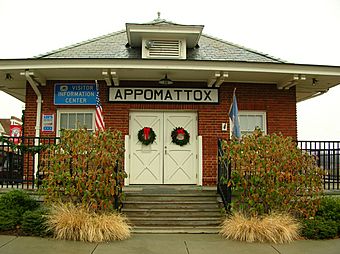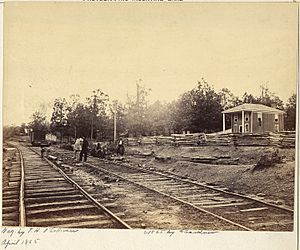Appomattox Station facts for kids
Quick facts for kids |
|
|
Appomattox Depot
|
|
|
U.S. Historic district
Contributing property |
|

The former Appomattox Norfolk and Western Station in December 2007
|
|
| Location | Church Street & Main Street, Appomattox, Virginia |
|---|---|
| Built | 1923 |
| Architect | Norfolk and Western Railway |
| Part of | Appomattox Historic District (ID02000510) |
| Designated CP | May 16, 2002 |
The Appomattox Station was a very important place in Appomattox, Virginia. It was here that a major battle, called the Battle of Appomattox Station, happened. This battle took place just one day before General Robert E. Lee surrendered his army to Lieutenant General Ulysses S. Grant. This event effectively ended the Civil War.
The original Appomattox Station was destroyed by fire in 1898. Its replacement also burned down in 1923. The railway station you see today, built close to the original spot, is known as the Appomattox Depot (from 1923). This building is part of the Appomattox Historic District. Today, the depot serves as the Appomattox Visitor Information Center.
The Last Battle at Appomattox Station
There is a special marker at the Appomattox Depot. It tells the story of the final moments for General Robert E. Lee and his army during the Battle of Appomattox Station in 1865.
You are standing near the site of Appomattox Station Depot on the South Side Railroad. Here, on the afternoon of April 8, 1865, Union cavalrymen under Gen. George A. Custer dealt the Army of Northern Virginia a final blow. First, they captured trains loaded with supplies for Confederates, then they attacked and captured Gen. R. Lindsay Walker’s wagons and artillery in bivouac half a mile to the north.
When word of this disaster reached Gen. Robert E. Lee at his headquarters a few miles northeast, he knew the end was near. He and Gen. Ulysses S. Grant had exchanged letters on the subject of surrender, and Lee had suggested a meeting between the lines the next day. With Union horsemen now blocking his escape route, Lee’s only hope lay in punching through them with a combined force of infantry and cavalry, and he scheduled a breakout attack for dawn. If it failed, or if he found Federal infantry in front of him as well, then he would have no choice but to surrender.
What Happened at the Battle?
On April 8, 1865, Union cavalry soldiers, led by General George A. Custer, delivered a major blow to the Confederate Army. They first captured trains full of supplies meant for the Confederates. Then, they attacked and took over wagons and cannons belonging to General R. Lindsay Walker.
General Lee's Realization
When General Robert E. Lee heard about these losses, he knew his army was in a very difficult situation. He had already been talking with General Ulysses S. Grant about surrendering. Lee had even suggested they meet the next day.
With Union soldiers now blocking his escape, Lee's only chance was to try and break through their lines. He planned an attack for early the next morning. However, he knew that if this attack failed, or if he found more Union soldiers in front of him, he would have no choice but to surrender. This battle set the stage for the end of the Civil War.
| Preceding station | Norfolk and Western Railway | Following station | ||
|---|---|---|---|---|
| Phoebe
toward Cincinnati
|
Main Line | Pamplin
toward Norfolk
|
||




